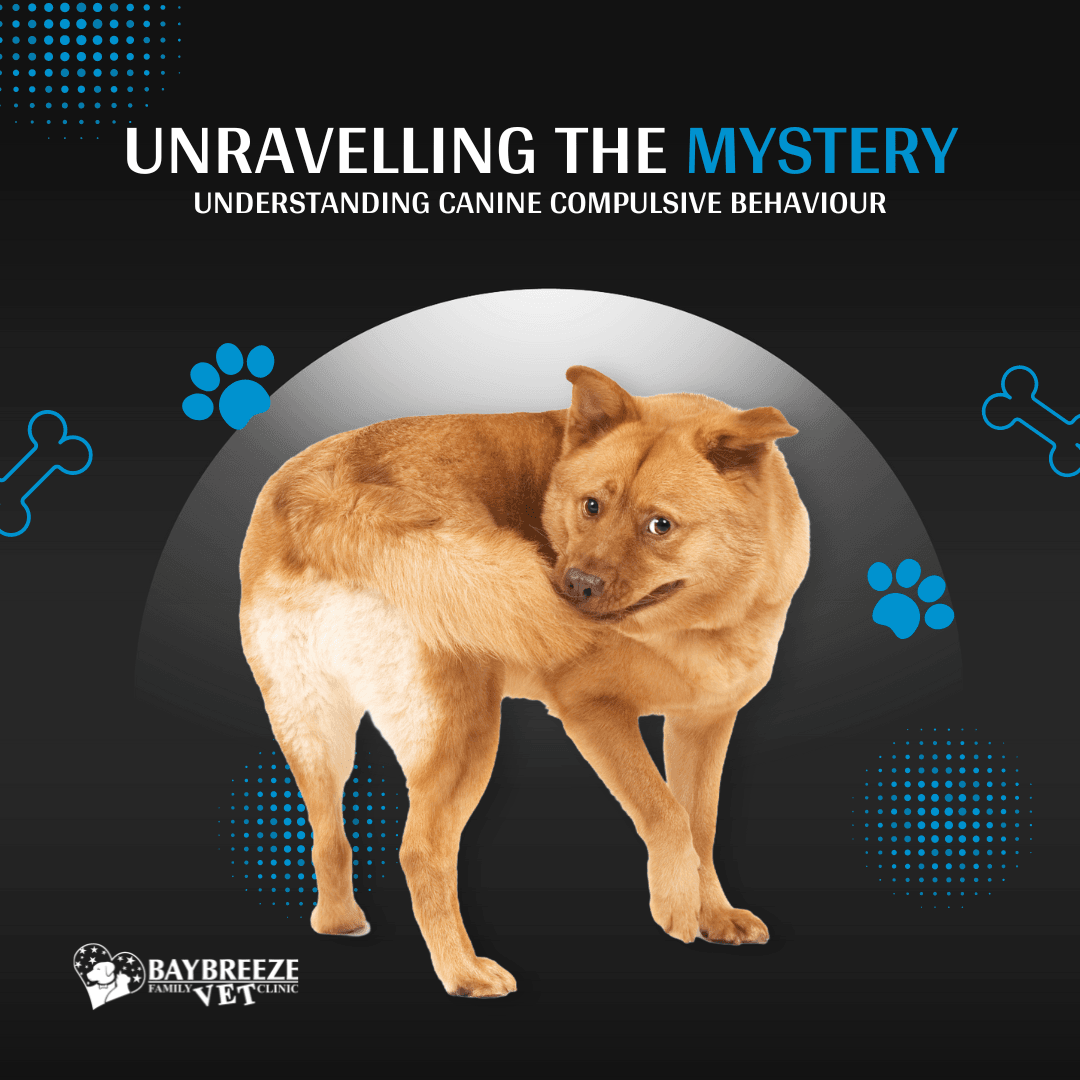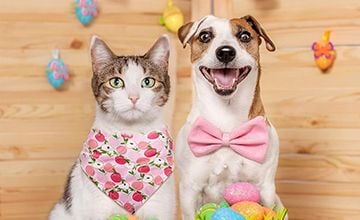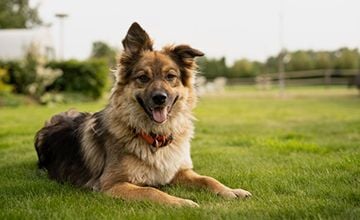Ensure Your Pet Safety : Essential Tips To Prevent Them from Getting Lost
)
Being a pet owner brings immense joy, but with that comes the responsibility of keeping your beloved companion safe. In Australia, thousands of pets go missing every year, leaving their owners heartbroken. July, recognised as National Lost Pet Prevention Month, reminds us of the importance of taking proactive steps to prevent this distressing situation.
We understand how much your pet means to you. In this guide, we’ll outline key measures you can take to keep your furry friend safe and reduce the risk of them getting lost.
Why Pets Go Missing: Common Triggers
Before implementing strategies to prevent your pet from wandering off, it’s important to understand why they might stray in the first place:
- Unfamiliar Environments: Strange noises, new scents, or unfamiliar animals in the area can make pets feel uneasy, causing them to run in search of safety.
- Home Security Gaps: Pets often find escape routes through unsecured fences, windows, or doors.
- Fear and Panic: Stressful events like thunderstorms, fireworks, or even separation anxiety may trigger a flight response, leading pets to bolt.
- Natural Instincts: Pets that haven’t been spayed or neutered are more likely to wander in search of a mate, increasing the risk of them getting lost.
The Importance of Proper Identification
Identification is the most effective way to ensure your pet is returned to you if they go missing. Here are the two main types of pet identification:
- Collar and ID Tag: Your pet should always wear a collar with an ID tag that includes up-to-date contact information, even if they are primarily an indoor pet. The tag should list your phone number and address, providing a quick and easy way for someone to contact you if your pet is found.
- Microchipping: A microchip provides a permanent, reliable form of identification that can’t be lost. This small device, implanted under your pet’s skin, stores a unique identification number that can be scanned by veterinarians and shelters. Make sure to keep your contact details in the microchip registry current to improve the chances of a safe reunion.
Home Security: How to Pet-Proof Your Property
A critical part of preventing your pet from escaping is securing your home:
- Check Your Fence Regularly: Look for any gaps, holes, or weak spots that might allow your pet to squeeze through or dig under. If necessary, install barriers such as wire mesh along the fence line to prevent digging.
- Secure Windows and Doors: Ensure that all windows have strong, intact screens, and that doors and gates are fitted with secure locks. Even the most obedient pet may be tempted to run if they see an open window or door.
- Watch Out for Escape Artists: If your pet has a history of escaping, take extra precautions, such as tethering them on a long lead when outdoors, but always under supervision to avoid injury.
Managing Stressful Situations: Keeping Your Pet Calm
Many pets try to escape when they’re stressed or anxious, particularly during noisy or chaotic events:
- Create a Safe Space: Set up a quiet, secure room in your home where your pet can retreat during stressful events like parties, deliveries, or fireworks. This space should have bedding, toys, food, and water to help keep them comfortable and relaxed.
- Desensitisation Training: If your pet has severe anxiety triggered by specific sounds like storms or fireworks, desensitisation training may help. This technique, often guided by a professional trainer, involves gradually exposing your pet to the sounds in a controlled environment, helping them build tolerance and reduce their fear over time.
Spaying and Neutering: Why It’s Important
Spaying or neutering your pet has multiple benefits, including reducing their desire to roam in search of a mate. Pets that have not been desexed are more likely to wander off, increasing the risk of them getting lost or injured. Additionally, desexing offers several health benefits, such as preventing certain types of cancers and improving overall well-being.
Training for Safety: Building a Trustworthy Pet
Obedience training is a key component of lost pet prevention. Teaching your pet basic commands such as “come,” “stay,” and “sit” can be life-saving, particularly in outdoor environments where they might encounter distractions or threats. A well-trained pet is less likely to run off when startled and more likely to return when called.
What to Do If Your Pet Goes Missing
Even with the best preventative measures in place, pets can still go missing. Here’s what to do if it happens:
- Start Your Search Immediately: Begin by searching your immediate area and calling your pet’s name. Check familiar hiding spots and ask your neighbours if they’ve seen your pet.
- Contact Local Shelters and Vets: Notify local animal shelters, vet clinics, and animal control agencies as soon as possible. Share your pet’s microchip information, a description, and a recent photo.
- Leverage Social Media: Post on local community groups and lost pet pages on social media platforms. Include clear pictures of your pet and details like their last known location, any distinguishing features, and your contact information.
At Baybreeze Veterinary, we’re passionate about helping you keep your pet safe and secure. We offer microchipping services, as well as advice on desensitisation training and other preventative measures.
Contact us today to schedule an appointment and learn more about how we can support your pet’s well-being.
Caring For Your Pets During Winter
)
As the colder months settle in, many of us find comfort in snuggling up with warm blankets and cosy slippers. However, it's essential to remember that our furry friends also feel the effects of winter. Just like we take extra steps to stay comfortable, it's important to extend that same care to our pets. Here are some friendly tips to help you keep your pet happy and healthy during the winter season.
Providing Extra Care for Senior Pets
If you've noticed your senior pet struggling a bit more with daily activities or moving slower during walks, it's likely they're feeling the effects of colder temperatures. Just like us, older pets can experience discomfort from the drop in temperature, which can exacerbate stiffness and arthritis. It's essential to adapt their exercise routine accordingly to ensure their well-being during the winter months. Consider shorter walks, no more than 20 minutes a day, and focus on gentle exercises that promote circulation and cardiovascular health. Additionally, keeping an eye on your pet's weight is crucial, as extra pounds can intensify joint pain, especially in colder weather. By providing a little extra care and attention, you can help your senior pet stay comfortable and active throughout the winter.
Ensuring Warmth for Every Family Member
Just as we seek refuge indoors to escape the cold, it's important to prioritise the comfort and safety of our pets during the winter months. Exposure to harsh weather conditions can pose significant health risks to our furry companions, so providing them with adequate shelter is paramount. Consider these tips to create a cosy haven for your pet during winter:
Provide a warm, draft-free resting area elevated off cold surfaces.
Limit outdoor exposure for your pet, as they can be susceptible to hypothermia.
If outdoor time is necessary, ensure they have access to a sheltered kennel protected from wind and rain.
Supply plenty of warm bedding or blankets for added comfort.
For older pets or those with shorter fur, consider fitting them with a snug pet coat to help retain heat.
Keep cats indoors unless they have access to a secure outdoor enclosure.
Offer your dog a designated indoor sleeping area, such as a comfy bed in the laundry or a suitable crate.
When washing and grooming your pet, use warm water and consider using a dryer to prevent them from getting chilled with wet fur.
By taking these simple yet crucial steps, you can ensure that every member of your family, including your beloved pets, stays warm and safe throughout the winter season.
Prioritise Exercise Even in Cold Weather
While the chilly temperatures may dampen our motivation to venture outdoors, maintaining regular exercise for your pet remains essential for their overall health and well-being throughout the year. Skipping exercise routines can predispose your dog to various health issues like diabetes and weight gain, or may lead to behavioural problems stemming from boredom. If the cold weather disrupts your daily walks, consider adjusting your schedule to incorporate exercise during the warmer parts of the day. If braving the cold isn't feasible, explore alternative indoor activities such as trick training or puzzle games to keep your pet mentally stimulated and content. Additionally, winter presents an opportune time to focus on teaching manners and obedience skills. Remember to use plenty of tasty treats during training sessions, and afterward, reward yourselves with a cosy cuddle session on the couch. By prioritising exercise and mental stimulation, you can ensure that your pet remains happy, healthy, and engaged, regardless of the weather outside.
Canine Compulsive Disorder: Recognising and Managing Repetitive Behaviours in Dogs
)
Dogs can sometimes exhibit repetitive behaviours that, when left unchecked, may develop into a more serious condition known as Canine Compulsive Disorder (CCD). This behavioural disorder, akin to human obsessive-compulsive disorder, leads dogs to engage in repetitive actions that can affect their wellbeing. While we cannot know if dogs experience obsessive thoughts, their compulsive behaviours clearly indicate distress. Understanding CCD and its treatment is crucial for ensuring your dog’s health and happiness.
Identifying the Symptoms of Canine Compulsive Disorder
Many behaviours associated with CCD may seem normal at first but can become extreme and frequent over time, leading to self-injury and disruption to daily life. Common symptoms of CCD include:
- Persistent licking or biting of the skin, often causing fur loss or raw patches, particularly around the tail and limbs.
- Repetitive behaviours that continue even when the dog is physically restrained.
- Obsessive tail chasing, sometimes resulting in injury to the tail.
- Compulsive actions become more frequent or last longer over time, disrupting regular routines.
- Certain behaviours may start after a specific event but often have no clear trigger.
- The dog may become less playful as their compulsive tendencies take hold.
Early intervention is key to preventing these behaviours from worsening and causing further harm to your dog.
What Causes Canine Compulsive Disorder?
CCD can be triggered by a combination of physical, emotional, and genetic factors. Recognising these triggers can help manage and prevent the disorder from developing.
- Pain and Discomfort: Chronic pain or discomfort from injuries or health conditions can cause dogs to obsessively focus on certain areas of their bodies. Even when the underlying issue is resolved, compulsive behaviours can persist as a learned habit.
- Environmental and Social Stress: Dogs are sensitive to changes in their environment, and disruptions to their routine or home life can trigger anxiety. Common stressors include moving homes, new pets or family members, or even daily separation from their owners. These stresses can lead to compulsive behaviours as dogs attempt to cope with their anxiety.
- Genetics: Certain breeds are genetically predisposed to compulsive behaviours. For example, Doberman Pinschers often exhibit acral lick dermatitis, while Cavalier King Charles Spaniels may engage in fly snapping or shadow chasing. Recognising breed-specific tendencies can help owners manage CCD more effectively.
Diagnosing and Treating Canine Compulsive Disorder
To diagnose CCD, your vet will perform a thorough examination to rule out other medical conditions that might be causing the behaviour, such as allergies, infections, or neurological disorders. Once CCD is confirmed, a multifaceted treatment plan will be recommended, focusing on reducing stress and managing compulsions.
- Physical Exercise: Regular exercise tailored to your dog’s breed and health needs helps manage stress and reduces the energy that can fuel compulsive behaviours.
- Mental Stimulation: Keep your dog’s mind engaged with puzzle toys, training exercises, or games. Providing mental challenges can help distract your dog from compulsive actions and give them a sense of purpose.
- Behavioural Distraction: When your dog begins engaging in compulsive behaviours, redirect their attention with alternative activities like playtime or training. Avoid using treats as a distraction, as this may reinforce the behaviour.
- Medication: In more severe cases, medication such as antidepressants or anti-anxiety drugs may be prescribed to help control compulsive behaviours. These medications often take several weeks to become fully effective and require consistent administration.
At Baybreeze Veterinary Hospital, we work closely with pet owners to develop personalised treatment plans that address both the symptoms and underlying causes of CCD. With the right approach and care, dogs with CCD can lead healthier, happier lives.
Easter Pet Safety Tips
)
Did you know, just 50g of chocolate can be toxic and kill a dog!
The problem is that the systems of cats and dogs cannot tolerate theobromine, one of the key ingredients of chocolate. Theobromine can cause a range of problems in domestic animals because it triggers the release of adrenaline, which can lead to a greatly accelerated heart rate and an irregular heartbeat.
Some signs your pet may have ingested chocolate:
- Vomiting
- Diarrhoea
- Excessive Urination
- Hyperactivity
In serious cases, pets can become depressed, enter a coma, have seizures and die. If you think your pet has eaten something it shouldn’t, call Animal Emergency Services or Baybreeze Vets straight away!
But chocolate isn’t the only potential hazardous food for pets. Some others include: hot cross buns, raisins, grapes and sultanas, onions, corn cobs, cooked bones and fatty BBQ foods.
Fatty foods in BBQ left overs can affect the animals’ pancreas and lead to pancreatitis. Cooked bones can also cause major problems. They’re brittle and the sharp slivers can either lodge in the throat or pierce the stomach lining.
If you’re planning on holidaying with your pets this Easter, remember their safety!
Never leave your pets unattended in or on vehicles, and please appropriately restrain your dogs on the back of utes when travelling. We don’t want to see dogs flying from vehicles again this holiday season.
If you can’t take your pet on holiday, consider booking a reputable pet sitter through someone like PetCloud and register your pet’s details with the RSPCA’s Home Alone service.
As always, if you require any assistance or advice, please feel free to contact Baybreeze Vets today!
Protect Your Dog From Heatstroke!
)
With the current heatwaves we are experiencing in Queensland, heatstroke can be a life threatening side effect. Heatstroke is an emergency, and in Dogs, it can lead to rapid multi-organ failure and has a high mortality rate.
Signs of heatstroke in dogs may include: constant panting, rapid breathing and heart rate, pale or red gums, drooling, vomiting, diarrhoea, dizziness, weakness, confusion, muscle tremors, seizures, little to no urination, and collapse.
Minimising the risk of heatstroke involves addressing the risk factors. You can help prevent heatstroke via weight management, avoiding high risk breeds with exaggerated features like flat faces, providing sufficient water, avoiding hot surfaces (e.g. sand, concrete), exercising with your dog at coolest times of day and avoiding the hottest times of the day, and giving access to a cool, shaded area with good ventilation at all times.
Never leave your dog in a vehicle. Even on an overcast day with the windows down, dogs can still overheat and die in a short time.
If you suspect your dog is suffering from heatstroke, start emergency first aid. Try to cool your dog down by applying room-temperature or cool water to their fur/skin. To maximise heat loss, keep the environment cool (e.g. fan, air-conditioning). Contact us at immediately on (07) 3103 8432 if you suspect heatstroke and need assistance.
&geometry(269x80))





